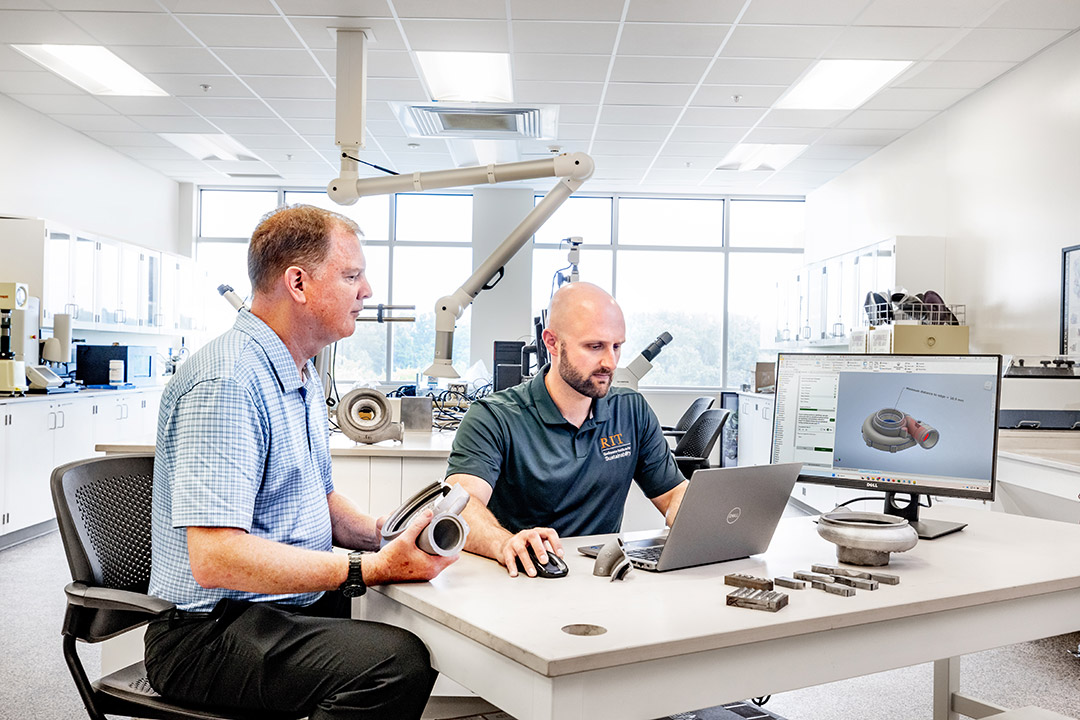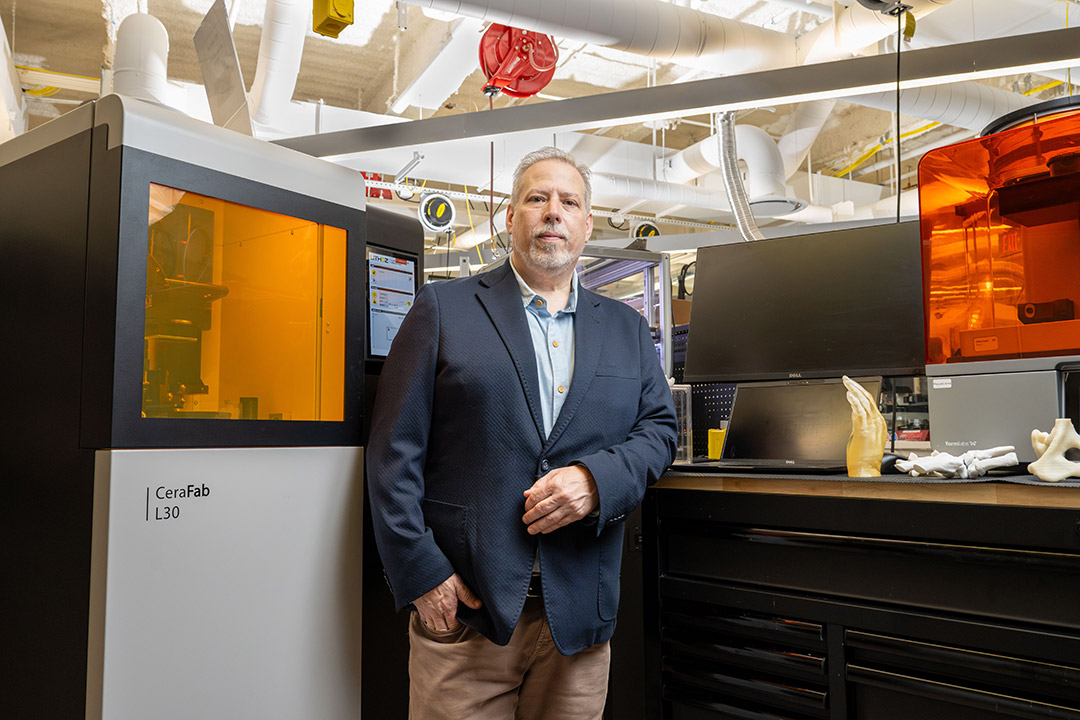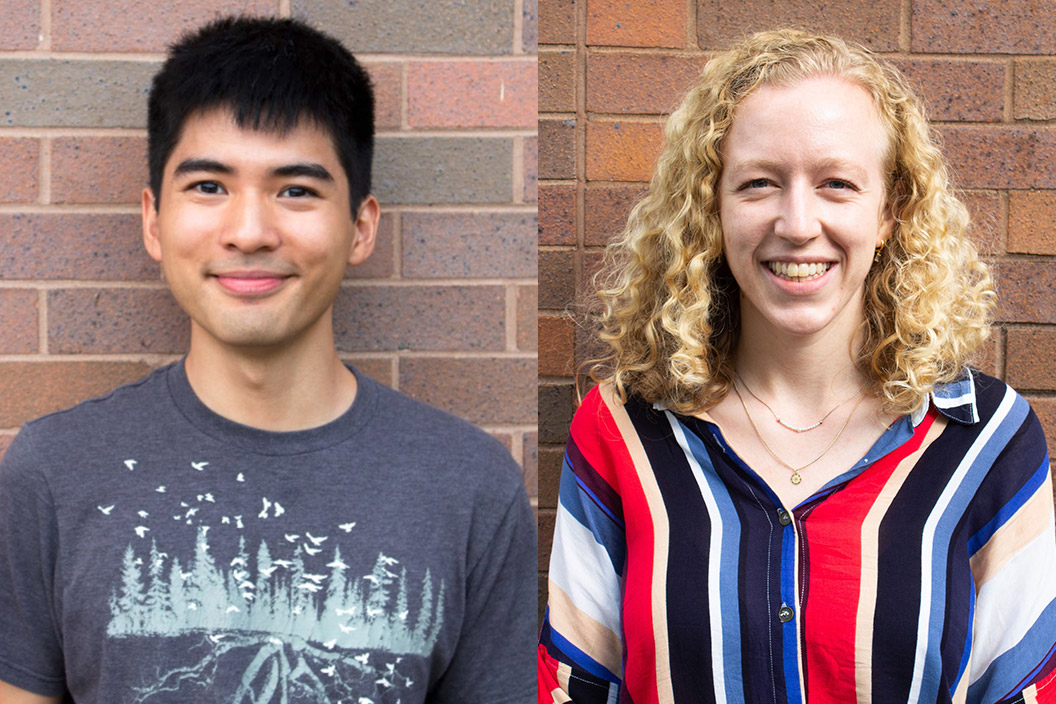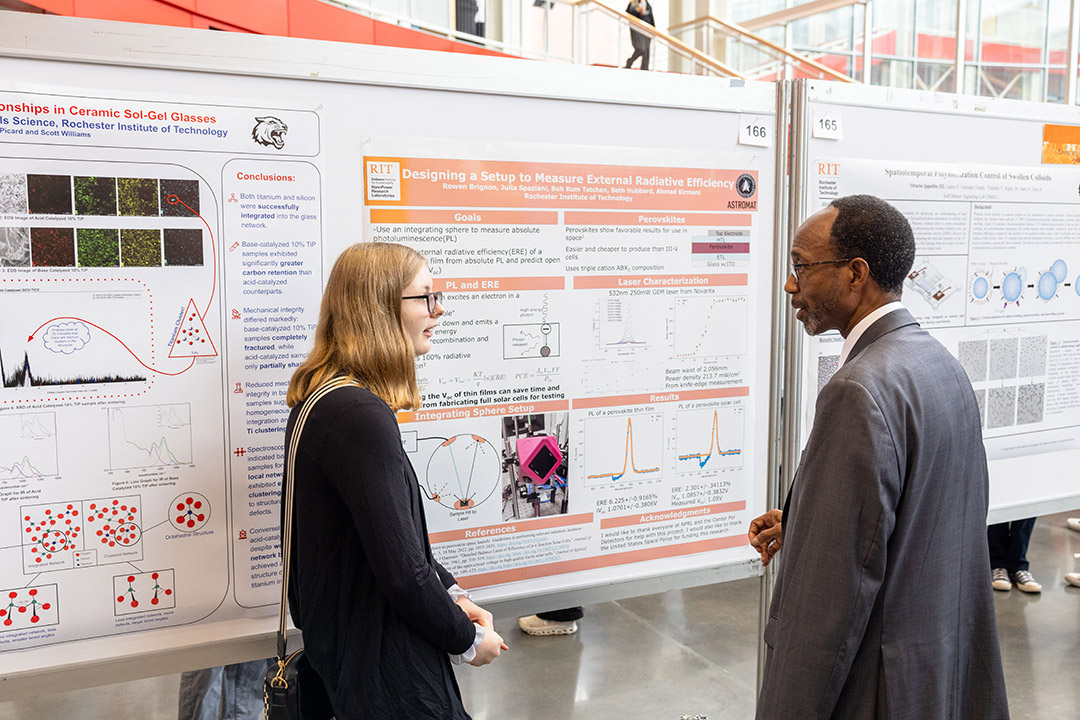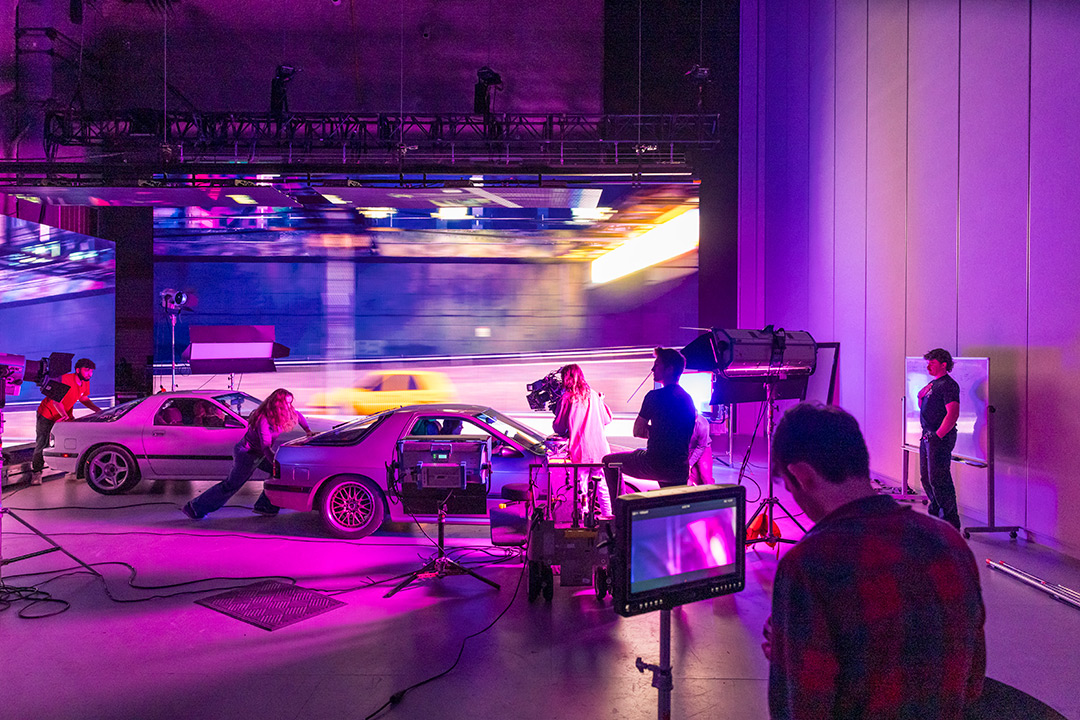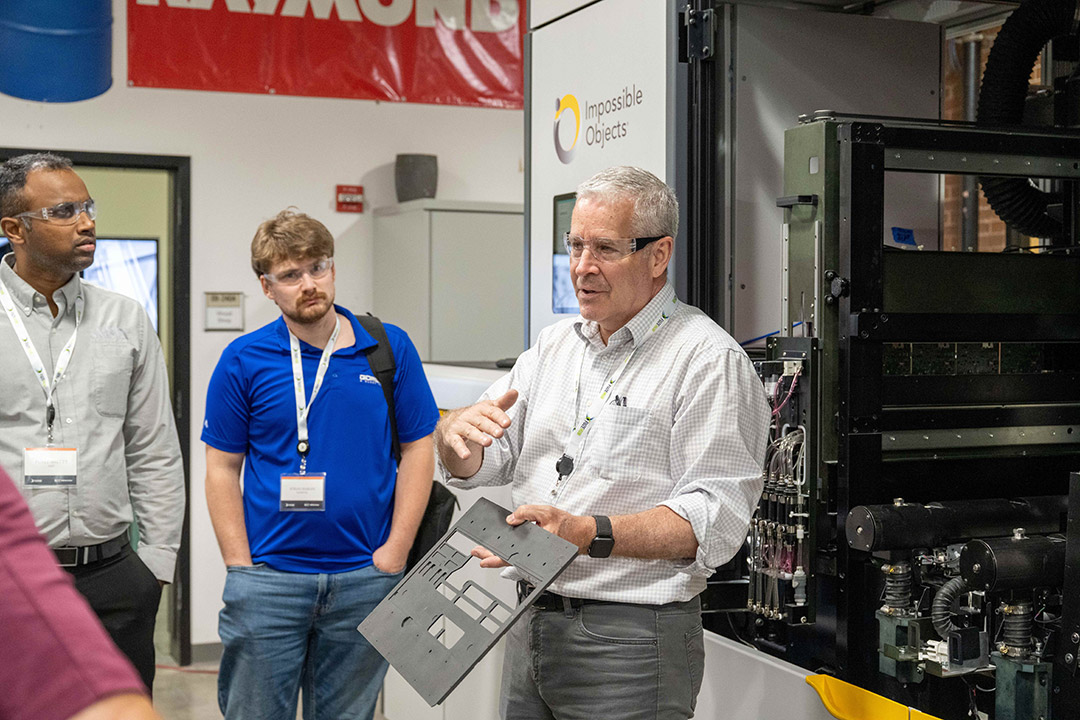New design platform allows engineers to think more sustainably
- Researchers at RIT’s Golisano Institute for Sustainability have developed PhoenixDFR, a software tool that helps engineers design products with remanufacturing in mind.
- The tool uses real-world industry data to flag design issues and guide improvements through web and CAD-based platforms.
- The team worked closely with companies from multiple sectors, including heavy equipment, HVAC systems, and automotive.
Brian Hilton, principal investigator (PI) and engineering manager at Golisano Institute for Sustainability (GIS), has been searching for solutions to an increasingly disposable society. When his 9-year-old refrigerator started failing, the repair quote came in at a price that was higher than the price of a new unit.
“There was a leak in the line somewhere,” Hilton said. “From an engineering standpoint, that should have been an easy fix. But the repair technician told me that given the difficult access to the lines and the lack of system modularity, I’d be better off buying a new one.”
That experience reflects a larger, global problem in product development—most products are not designed with longevity in mind and may contain features that make a second life technically or economically unfeasible.
To help solve this problem, engineers at GIS have developed a new software platform to help manufacturers design products that are easier to remanufacture. The tool, named PhoenixDFR, helps engineers think about sustainability earlier in the design process. The tool works both as a web app and as plug-ins within popular computer-aided design (CAD) software.
PhoenixDFR helps engineers evaluate product parts for attributes that could hinder remanufacturing, such as excessive wear, corrosion, or general material loss. The tool then guides users through a step-by-step decision process that highlights design fixes and workarounds, then generates a detailed report with screenshots, design suggestions, and a performance score based on a custom scoring system built by the team.
“We're not trying to tell the design engineer what to do,” said senior engineer Frank Zelinger. “A design engineer and a product manager will still weigh things like cost into the equation, but now you've given them another piece of information to think about.”
The system draws on a growing database of 25 remanufacturing failure modes and hundreds of design rules, collected from industry papers, textbooks, and during site visits to different manufacturers.
“They opened their doors and let us basically go dumpster diving at the end of a remanufacturing line,” Hilton said. “We asked a ton of questions and got insights that go beyond what you’d typically find in a concise journal article.”
Hilton said the team visited five sites across the country and worked closely with companies from multiple sectors, including heavy equipment, HVAC systems, and automotive.
“Having them be open to sharing pre-competitive information was a very important part of this,” he added. “It’s been a strong collaboration, and we couldn’t have done this without industry in the room.”
The team working on this project consists of Hilton, Zelinger, and senior engineer/Co-PI Scott Nichols, who leads software development. They were aided by a group of RIT co-op students, including and former co-op student and 2023 graduate Miko Buenk and third-year computer science student Jared Randall. They helped quantify environmental impacts of remanufacturing and address cybersecurity of the tool for use in industry settings, respectively.
PhoenixDFR was built with heavy equipment and industrial components in mind, but the team sees opportunities to expand into other product sectors—including consumer electronics, transportation systems, and appliances like Hilton’s refrigerator.
“There’s no reason why the principles behind this tool can’t apply to everything from kitchen equipment to laptops,” said Hilton. “Any time you can extend the life of a product, you’re getting more value out of the materials, energy, and labor that went into it.”
Although still in beta testing, PhoenixDFR is already generating strong interest among manufacturers. The team is exploring commercialization options.
“We want to push the envelope,” Hilton said. “We want people to think more about circularity and think more about sustainability and how to integrate that into product development. But today, let's work on remanufacturing.”
The tool began development in 2023, thanks to $1.96 million in grants from the REMADE Institute, a public-private partnership and Manufacturing USA innovation institute funded in part by the U.S. Department of Energy and Empire State Development.
This material is based upon work supported by the U.S. Department of Energy’s Office of Energy Efficiency and Renewable Energy (EERE) under the Advanced Manufacturing Office Award Number DE-EE0007897 awarded to the REMADE Institute, a division of Sustainable Manufacturing Innovation Alliance Corp. In addition, RIT received funding, in part, from New York State Empire State Development under grant #AC118 that supported the work on this project. The views expressed herein do not necessarily represent the views of the U.S. Department of Energy, the United States Government or New York State.
Latest All News
- Ph.D. student’s NASA-funded research leads to new insight on exoplanetsLike many Ph.D. students, Attila Varga’s professional pursuits include being a lead author on a published paper. But, getting his research featured on the front page of NASA’s website and in news outlets around the world is definitely a bonus. Varga, a astrophysical sciences and technology Ph.D. candidate at RIT, is proud of his research that has led to new understanding about a newborn exoplanet that is shrinking due to the harsh X-rays of its nearby host star. Named TOI 1227 b, the planet is the second youngest ever to be observed passing in front of its host star. While previous estimations put the planet’s age at 11 million years, Varga’s study found the planet to be 8 million years old, which is very young by planetary standards (by comparison, the Earth is about 5 billion years old). The team’s research on TOI 1227 b began when Varga noticed that one of the young stars he had been studying, named TOI 1227, had been identified as a potential exoplanet host by a separate NASA mission. After the exoplanet was confirmed, the research team, led by Varga and his dissertation adviser Joel Kastner, professor in the School of Physics and Astronomy and Chester F. Carlson Center for Imaging Science, used NASA’s Chandra X-Ray Observatory to measure the star’s intense high-energy radiation. Varga then led a series of computer models that demonstrated that the effects of this intense stellar X-ray bombardment of the planet was probably devastating. TOI 1227 b’s atmosphere is being blasted away and its mass is due to shrink. “It’s almost unfathomable to imagine what is happening to this planet,” said Varga. “The planet’s atmosphere simply cannot withstand the high X-ray dose it’s receiving from its star.” Varga’s work on the effects of young star X-rays on their newborn planets will continue as he, fellow astrophysical sciences and technology Ph.D. student Ryan Butler, and adviser Kastner were recently awarded Chandra observing time to measure X-ray radiation from another exoplanet host star that is even younger than TOI 1227. “When Attila told me that he had found an exoplanet host among the hundreds of young stars he had been studying, I have to say my jaw kind of dropped on the floor because it was such a significant discovery,” said Kastner. “You can learn a lot by looking at these very young planets to determine how our solar system came to be and if there are other solar systems like ours.” Along with Varga and Kastner, other collaborators on the paper published in The Astrophysical Journal include Alexander Binks from Eberhard Karls University of Tubingen in Germany, Moritz Guenther from Massachusetts Institute of Technology, and Simon Murphy from The University of New South Wales in Australia. The opportunity to work with researchers around the world and to have direct access to NASA telescopes like Chandra was what helped bring Varga to RIT. “I really like the research when the focus is X-ray astronomy,” said Varga. “It was really cool that we could propose time with Chandra and get the data back, and have such definite measurement of this young exoplanet host star’s X-ray radiation. It’s exciting, and it puts all the work in my classes and experience I’ve been getting together really nicely.” For Kastner, supervising a Ph.D. student making such discoveries is just as rewarding. “Seeing him get to the place where he’s making major advances in exoplanet research with data collected from a major international observatory is wonderful,” said Kastner. “Even better, he’s done so by taking the research initiative and leading an international team of recognized experts in the field.”
- RIT offers occupational therapy clinical doctorate degree in 2026Rochester Institute of Technology’s newest doctoral degree offers a personalized approach to helping people with illnesses or disabilities participate in life. An entry-level clinical doctorate in occupational therapy (OTD) will launch in June 2026. The program will focus on innovative interventions and adaptive devices that extend patients’ functional skills. The OTD program represents the university’s first clinical doctorate degree. Pete Schuck/RIT RIT’s clinical doctorate in occupational therapy looks to the future of adaptive design. Here, Christopher Alterio, OTD director, and Marcia Shea, OTD clinical coordinator, tour the AMPrint Center and learn about integrated prosthetic research that could revolutionize occupational therapy. “Occupational therapy is about function, participation, and adaptation,” said Christopher Alterio, director of RIT’s occupational therapy doctoral program. “Occupational therapists work across a variety of different settings and diagnoses, helping people do the things they need and want to do in the context of their real lives.” The future-facing and collaborative program will develop clinicians who are comfortable working with engineers, designers, and data scientists to create meaningful solutions for people, he said. “Our students will work in AR/VR environments and design custom orthotics and prosthetics in 3D-printing labs,” Alterio said. “They will learn how to evaluate emerging tools that are still being tested in research settings.” The three-year clinical doctorate, approved by the Accreditation Council for Occupational Therapy Education and the New York State Education Department, is housed within RIT’s Wegmans School of Health and Nutrition. The program will prepare graduates to work with people of all ages at schools, hospitals, and outpatient clinics. The program consists of nine consecutive semesters, a capstone, and required fieldwork, and blends a traditional curriculum with innovative technology and experiential learning. Completion of the program qualifies graduates to sit for the national certification exam administered by the National Board for Certification in Occupational Therapy. U.S. News Careers ranks occupational therapy as the eighth best health care career in 2025. Increased retirement rates within the profession create opportunities for the next generation to bring new energy to the field. The U.S. Bureau of Labor Statistics projects the need for occupational therapists to grow by 11 percent through 2033 and reports a median annual wage of $98,340. The expansion of RIT’s health sciences programs will help address workforce shortages in the health sector, starting with occupational therapy, according to Yong “Tai” Wang, dean of RIT’s College of Health Sciences and Technology. OTD’s focus on patient experience and capstone research distinguishes it from RIT’s 13 Ph.D. programs. “Healthcare workforce demands present an opportunity for RIT to make an impact beyond the region,” Wang said. “Our OTD program will educate a new type of clinician who approaches patient-centered care with a technology mindset.” The OTD lab will give students experience working in augmented- and virtual-reality (AR/VR) spaces for immersive rehabilitation, traditional outpatient therapy environments, and a large pediatric play space. Occupational therapy at RIT will tap into the synergy of technology, the arts, and design on campus, Alterio said, and explore possibilities through AR/VR simulations, personalized 3D-printed prostheses, and apps that gamify OT. Close proximity to research labs, studios, and makerspaces across campus gives the OTD program an edge, Alterio said. Occupational therapy is a multidisciplinary field with overlap in health sciences, engineering, computer science, and industrial design, among other areas. Researchers at RIT’s AMPrint Center, for instance, develop and test additive manufacturing and 3D-printing technologies and materials. Ongoing research in 3D-printed orthotics and personalized prosthesis technology integrated with tissue engineering has OT applications. Accessible design challenges, such as RIT’s Studio 930, give students other opportunities to work in multidisciplinary teams and apply design thinking to real problems. OTD students can gain experience interacting with clients representing the Al Sigl Community of Agencies and the RIT-Rochester Regional Health Alliance, a strategic partnership between the university and the health system. “We want to make it the norm in occupational therapy to work with people who are always advancing technology,” Alterio said. “I want to model a spirit of collaboration so we can bring the kinds of amazing ideas that are happening on campus into the field and directly to patients.” For more information about RIT’s OTD program, contact Alterio at cjachst@rit.edu.
- Two students win competitive NASA awards for graduate researchStudents Allen Wen and Sadie Coffin wrote two of 24 proposals accepted in the astrophysics category out of 456 submissions. Wen, advised by Professor Yosef Zlochower from the School of Mathematics and Statistics, will be modeling multiwavelength signals from binary neutron star mergers. Coffin, under the direction of Associate Professor Jeyhan Kartaltepe from the School of Physics and Astronomy, will be leveraging citizen science measurements to efficiently identify galaxy pairs. FINESST awardees must be the primary author of the research and will receive $50,000 per year for up to three years. RIT is one of just two schools nationwide to have more than one FINESST proposal in astrophysics accepted, and those two are in two different research centers associated with the Ph.D. program: The Center for Computational Relativity and Gravitation and the Laboratory for Multiwavelength Astrophysics. “It speaks to the emphasis on excellence that we have in the program,” said Zlochower. “It’s unusual to get one student winning. Two is quite remarkable.” In 2017, the first binary neutron star merger that detected both gravitational waves and a light signal from the same event was observed. That left a lot of data to be analyzed and explained. Wen will be creating big simulations to try to answer why the light signal looked the way it did, what different things could be active at the sight of the merger, and how these events can impact the light signals we observe. He credits the entire research group with helping him prepare a successful proposal. “We have a very open and collaborative environment,” said Wen. “I could get help from other grad students, junior researchers, and professors and get all sorts of feedback. The collaboration helps in both writing this one proposal and in day-to-day research, as well.” Coffin is enlisting citizens to be trained and then to help comb through spectroscopic data to study galaxies through the Redshift Wrangler project. The project uses volunteer contributions to identify and analyze galaxy pairs at high redshift. Previous studies on galaxies have limited sample sizes, but using citizen science helps astronomers comb through data faster. “We have this problem that the spectra we have right now are somewhat manageable, but over the next several years, we’re going to be inundated because there will be a lot of instruments providing millions of spectra,” explained Kartaltepe. “Nobody will be able to look at every single object anymore. Projects like this where you can crowdsource some of the measurements can be really useful.” The FINESST funding for the project will also help bring real science to people around the world, hopefully growing an interest in the overall work and making high-level research available to anyone. “I’m really excited about making science more open,” said Coffin. “We welcome anyone to be a part of our scientific research. We benefit from diverse perspectives. It’s fun to see the different paths to studying these big questions about the universe.”
- RIT undergraduates share the impacts of their researchRIT student Rowen Brignon had been rehearsing her research presentation on solar cells for weeks but never imagined that she would be sharing her work with NASA leader and RIT alumnus and trustee Clayton Turner. “I can’t even believe this,” said Brignon, a fourth-year physics major from Buffalo, N.Y. “Just the fact that I was able to talk to him about the impact of my research on the future of solar cells in space, and that he was so engaged in my work, is a dream come true.” Pete Schuck/RIT Psychology student Sayyada Khaki, left, reviews her poster on her research on maternal health with her faculty mentor Stephanie Godleski. Godleski understands the impact she has on undergraduate students when it comes to developing their professional skills and ensuring student success. Brignon was one of more than 150 students who presented their findings at this year’s Undergraduate Research Symposium on July 31. Turner, a 1990 electrical engineering graduate and NASA’s associate administrator for the Space Technology Mission Directorate, returned to campus to offer the event’s keynote address. As he walked through rows of research displays in the SHED, he was amazed by the level of dedication displayed by the students. “I can hear the excitement in the students’ voices as they explain their research,” Turner said. “When I was a student here at RIT, I was involved in research, but I didn’t do anything like what these students are doing. They are finding the solutions to the world’s problems faster than ever before.” From artificial intelligence to health sciences, sustainability, engineering, and more, students from every college had the opportunity to talk about their research. By blending her interests in psychology and public health, fourth-year student Sayyada Khaki is hoping that her research will improve public understanding of maternal health. “The part of psychology that first drew me in was the idea of using research to understand why and how people make the choices they do. But I also believe that we can use data to improve our communities by empowering vulnerable populations.” Pete Schuck/RIT Biochemistry student Gabriella Redman delivers her oral presentation on alternative methods of identifying and eradicating breast cancer cells during the Undergraduate Research Symposium. Khaki, who was born prematurely in Tanzania, is cognizant of the lack of prenatal care that, she said, leads to high rates of maternal and child mortality in many low-income countries. “Working on research as an undergraduate has given me the opportunity to see what a career in this field would look like and improve on the skills and knowledge I learn in many of my psychology classes. This is allowing me to gain a better feel for my future academic pursuits.” Faculty mentors play a key role in not only helping undergraduate students realize the impact of their research, but also in encouraging their successes through building lasting professional relationships. “My role as a faculty mentor is to promote research exploration and independence while also providing support, encouragement, and opportunities for growth in technical knowledge and skills,” said Stephanie Godleski, associate professor in the Department of Psychology and Khaki’s mentor. “For me, fostering undergraduate student research interest and engagement is one of the most important and rewarding parts of being a faculty member.” Pete Schuck/RIT Eduard Velazquez, a fourth-year computer engineering technology major, presents his talk on machine learning-based monitoring of wireless Internet of Things devices at this year’s Undergraduate Research Symposium. Gabriella Redman, a fourth-year biochemistry student from Rochester, N.Y., is working on an emerging treatment for breast cancer that uses dyes and light beams to target cells. “I didn’t think that I would become so interested in research, but being in a lab gets me excited,” she said. “Gathering samples and seeing a hypothesis proved as true is so cool.” As for Brignon’s research, Turner sees the promise in her work as he looks at a photo of his young grandson. “The number one challenge when considering the lunar surface is power,” he explained. “The work that Rowen is doing now on solar cells is going to enable this young child and his peers to one day live and work on the moon.” Pete Schuck/RIT More than 150 students from a variety of disciplines presented their work at this year’s Undergraduate Research Symposium on July 31 in the SHED.
- ‘The Hollywood Reporter’ names RIT as a top film school in the U.S. for second yearAccomplished alumni, creative technology research, and interdisciplinary program offerings set RIT’s School of Film and Animation (SOFA) apart from others on The Hollywood Reporter’s 2025 top film schools list. RIT was ranked number 22 this year, a leap ahead from the school’s rank in 2024. The Hollywood Reporter, an entertainment trade publication based in Los Angeles, cited RIT alumni in the industry—such as Chris Edwards ’97 (film production), founder and chief executive officer of visualization studio The Third Floor, and John Traver ’11 (motion picture science), co-founder and creative technologist of editing platform Frame.io—as a key indicator of the school’s success. Quinn Freidenburg New school director Ricky Figueroa emphasized that the creative minds and hard work of students, faculty, and staff is what has earned RIT’s recognition as a top film school. The publication wrote, “Finding future collaborators and a strong alumni network continue to be some of the biggest selling points for film schools.” The Hollywood Reporter also considered RIT’s facilities like MAGIC Spell Studios, student access to industry-standard equipment, and endowments supporting the film school when granting the ranking. Ricky Figueroa, director of SOFA, shared that a recognition like this highlights what’s most valuable in the school: the work of students, faculty, and staff. “This is something that makes our community excited and inspires us for the future. There is nothing better than seeing our students and faculty being recognized among the best in the nation,” he said. Figueroa was recently appointed director of SOFA after teaching in the school for nearly 20 years. He previously served as director of the undergraduate motion picture science program. In February 2025, he was named the inaugural John Traver Endowed Professor. Over the last year, RIT has been increasingly recognized as a top film school by publications like TheWrap, Variety magazine, and Animation Career Review. Becoming a leader amidst this increased visibility energizes Figueroa as he looks toward the future of SOFA’s program offerings. “The recognition has the potential to attract additional internal and external collaborations and project opportunities for our community, which are essential for the continuous growth of our school,” said Figueroa. “It pushes us to keep moving forward and strive for even greater heights.” Those hands-on experiential learning opportunities continue to prove invaluable for RIT students. Programs like RIT in LA, which is set to welcome its fourth cohort this fall, create opportunities for students to live, learn, and work in Los Angeles for a full semester. This year, RIT in LA expanded its offerings to include a track in games in addition to the tracks in film and animation and transmedia storytelling. Other experiential learning opportunities, like continued involvement with the Coca-Cola Refreshing Films program and the recently established student exchange program with the Film and TV School of the Academy of Performing Arts in Prague (FAMU), add to the value RIT offers to current and prospective students. Go to RIT’s School of Film and Animation website to learn more about its program offerings.
- State renews AMPrint Center’s contract to continue advancing 3D-printing technologiesRIT’s AMPrint Center recently received a 10-year renewal contract from New York state to continue development of next-generation 3D-printing processes, materials, and applications. The renewal funding will be distributed in two five-year increments, and the first allotment of $5 million will be used beginning this fiscal year. The AMPrint Center was established in 2015 to help position New York state as a global leader in 3D-printing technologies through industry, government, and academic partnerships. New start-ups have matured in the state through AMPrint’s research, training, and support capabilities. Its team has also contributed technology to improve how high-performance materials, including metals and carbon fiber composites, are being used in 3D-printing applications, said Denis Cormier, director of the AMPrint Center. “The AMPrint Center is helping to breathe new life into this region’s world-renowned printing industry by applying its expertise to the rapidly growing 3D-printing universe,” said Cormier, the Earl W. Brinkman Professor of Industrial and Systems Engineering in RIT’s Kate Gleason College of Engineering. The center has an extensive range of high-tech 3D-printing equipment being used for research as well as hands-on educational and training resources for students, faculty-researchers, and corporate partners. According to Wohlers’ Associates, the global report on 3D printing and additive manufacturing stated that the industry grew from $5.1 billion in 2015 to nearly $22 billion in 2024. This renewal grant is a result of the integral work provided by AMPrint: to support and launch start-up companies and to help existing companies successfully adopt industrial grade 3D-printing and additive manufacturing technologies in real-world applications. For example, AMPrint is helping Rochester-based 3D printer company Impossible Objects develop a machine that produces ultra-strong and lightweight carbon fiber composite components. Impossible Objects recently installed what it refers to as the world’s fastest 3D printer, the CBAM-25 machine, in the AMPrint Center. The new printer becomes another in a series of high-end, high-tech—and very fast—3D printer assets at the university, and multiple funded projects are already underway at the AMPrint Center using this new carbon composite 3D printer. “There’s an acute need for high-speed 3D printers that can produce very strong, very light weight components for drones and other applications,” Cormier explained. Additional applications include the development of custom-made carrier boards for the soldering process used to make electronic circuit boards. With the newer, faster printing process, Impossible Objects’ capabilities reduce both time and cost to production. “This is a ground-breaking piece of industrial manufacturing equipment,” said Cormier. “If you visualize a digital printing press making magazines or newspapers, the paper is just flying through the machine. Now translate that into 3D printing; that is what Impossible Objects has done. They are using carbon fiber instead of paper. There isn’t any 3D-printing technology that touches this machine's print speed, while simultaneously making such high strength parts.” Beyond speed and strength, AMPrint has also been leading the development of a 3D printer that operates like an inkjet printer in which the ink is molten metal. Cormier recently received a $3 million Future Manufacturing Research grant from the National Science Foundation to bring this technology closer to commercialization. Specifically, the team is scaling up the speed of this printing technology and is also expanding the types of molten metals that it can print. They expect to see it in commercial use within the next five years. “I’m biased of course, but I believe that this metal 3D-printing technology has the potential to transform the way many metal parts are made. Instead of mass-producing parts that are shipped halfway across the world for storage in huge warehouses, it will be possible to locally print metal parts on-demand just before they are needed,” said Cormier. On campus, several 3D-printing classes are available for undergraduate and graduate students using the AMPrint Center's broad range of equipment to ensure there is a pipeline of skilled engineers that can incorporate 3D-printing technology into varied industries. These classes range from Introduction to 3D Printing and Personalized 3D Printing to Metal and Composite 3D Printing. Students are learning about 3D printing processes and applications through coursework, research projects, and internships with the AMPrint Center's industry partners. Companies can also use any of the different industrial-grade machines or provide prototype devices for testing before commercialization. The AMPrint Center is involved in a diverse range of other industry and government funding projects. A collaboration between RIT and Alfred University is underway to develop a novel technique for 3D-printing glass structures that can go from ultra-low to ultra-high temperatures without cracking or breaking. The center team is also helping a company to develop a 3D printer capable of producing full color customized dentures.



